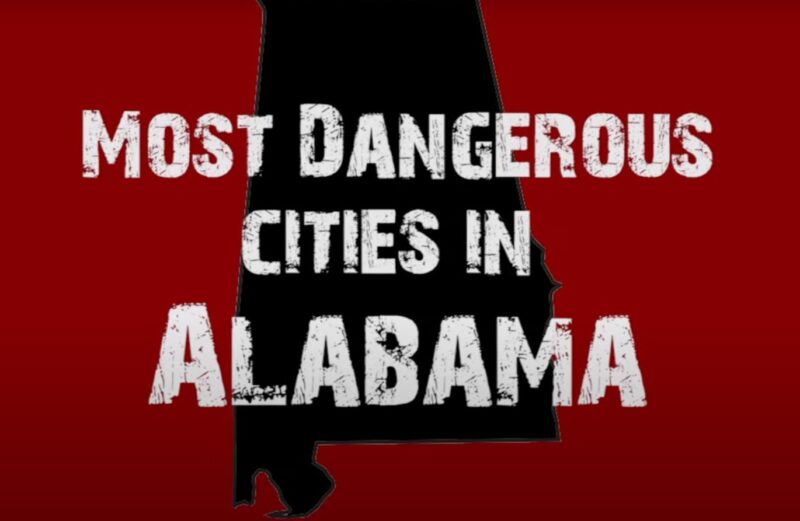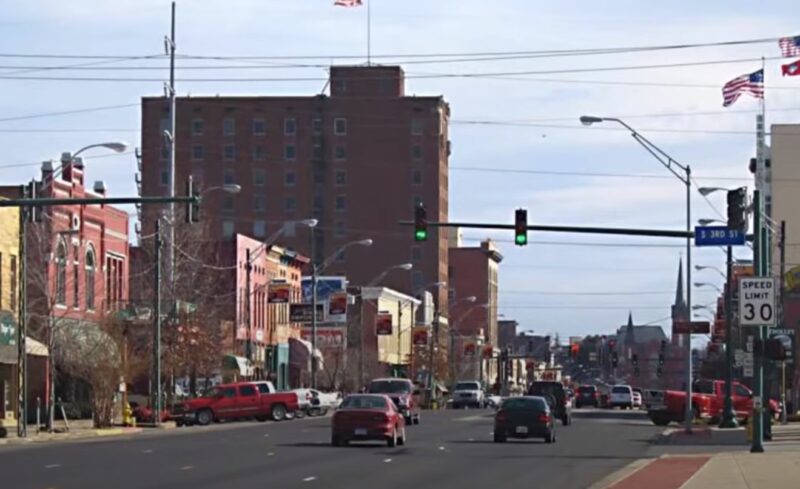My private multi-year research says that (and also according to the Global Peace Index) the United States is the 128th-safest country in the world out of 163 countries.1
With frequent headlines of hate crimes, mass shootings, natural disasters, and terrorist attacks, the United States can be potentially dangerous for citizens and visitors.2
I gave each state a total score out of 100.
I used indicators such as the Number of Fatalities per 100 million Vehicle Miles of Travel; Number of Law-Enforcement Employees per Capita; Number of Assaults per Capita; Bullying Incidence Rate; Unemployment Rate; Share of Uninsured Population; Percentage of Adults with Rainy-Day Funds; Total Loss Amount from Climate Disasters per Capita; and Number of Fatal Occupational Injuries per Total Workers.
Here is my list of the top 10 states in the U.S. with the highest crime rate.
“Stars cannot shine without darkness.” – D.H. Sidebottom (This suggests that challenges like crime can lead to stronger, united communities)
10. Tennessee

Finishing out the top ten with an overall score of 42.60 is Tennessee.
The state ranks 50th for Personal & Residential Safety.
In 2020, the state had 11.5 murders per 100,000, the eighth-highest homicide rate in the country stated by World Population Review.
| Tennessee state | Violent | Property | Total |
|---|---|---|---|
| Number of Crimes | 43,829 | 162,342 | 206,171 |
| Crime Rate (per 1,000 residents) | 6.22 | 23.02 | 29.24 |
So, Is it safe to live in Tennessee?
From my research, I found that there is a smaller percentage of all violent crimes in Tennessee (1% vs US 2%).
Despite this fact, the crime rate is higher – only 38% of Tennesseans say they feel safe3 in their state, which is below the US average of 45% and 17% lower than the previous survey.
Nashville is the capital and most populous city in the U.S. state of Tennessee.
All of these neighborhoods have a consistent amount of violent and property crimes that rank the highest per capita with 90-184% higher crimes than other Nashville neighborhoods.
Other areas to avoid include Osage-North Fisk, McKissack Park, and Shepherd Hills.
- Heron Walk: This neighborhood has a high number of violent and property crimes4, making it one of the most dangerous neighborhoods in Nashville with total crime 13,815.
- Glenncliff, West Meade, Talbot’s Corner, and Bordeaux: These neighborhoods also have a consistent amount of violent and property crimes.
- Talbot’s Corner and Hadley Park: These neighborhoods are considered the most dangerous in Nashville for 2024 based on crime data5.
9. Missouri
Missouri’s overall score is 41.48, making it the ninth-most dangerous U.S. state.
Missouri ranks 40th for Emergency Preparedness, with about 10% of residents missing health insurance.
It has the second-highest homicide rate in of 11.8 murders per 100,000 people.6
Most Dangerous Cities in Missouri
There are many safe locations but at the same time, high crime areas make Missouri in 2024 as one of the most dangerous states in the country.
Let’s see the list I made using sources like PropertyClub.7
10. Ferguson
Visitors should exercise caution and practice safety measures. When it comes to violent crimes, only 4% of US cities are more dangerous.
9. Bridgeton
As of July 2023, Bridgeton’s crime rate is trending upward, 10% higher than the same Feb-July six-month period in 2022.
8. Vinita Park

With murder coming in at over 7.5x higher than the national average annually and assault, rape, and robbery all topping our nation’s average, violent crimes rank high in Vinita Park.
7. Joplin
In the US, 19% of cities are considered more dangerous than Joplin.
6. Kansas City
Only 16% of US cities are considered more dangerous than Kansas City.
5. Branson

Only 15% of US cities are thought to be more dangerous than Branson.
The majority of crimes reported there are theft, burglaries, and assaults.
4. Kennett
Larceny and burglary also remain high threats here, with robbery accounting for approximately 75% of all crimes committed in Kennett.
3. Nevada
Nevada’s crime rate is 204% higher than the national average.
2. Springfield
A crime occurs every 45 minutes (on average) in Springfield. Residents in Springfield also face risks of violent crimes like assault and murder.
1. St. Louis
The most dangerous city in Missouri is St. Louis.
It is also one of the worst cities in the US regarding crime, with a crime rate that is 234% above the national average.
While St. Louis offers a rich history and cultural attractions, such as the Gateway Arch and the St. Louis Art Museum, it also faces significant challenges in terms of crime.
Ellie Bentley, 22, was dragged under a car for two blocks during a hit-and-run shooting in St. Louis.
Bentley, who’s British, moved to the US to be with her boyfriend and footballer Indiana Vassilev. She was a victim of a crossfire shooting, and suffered multiple broken bones… pic.twitter.com/mlAdvL9bR6
— Ian Miles Cheong (@stillgray) March 12, 2024
The city experiences high rates of violent crime, including homicides and robberies. Areas in central St. Louis and the downtown area are particularly known for high crime rates.
The Gravois Park neighborhood has a crime rate 323% higher than the national average.
8. Florida

As the eighth-most dangerous state, Florida ranks 47th for Road Safety and 43rd for both Emergency Preparedness and Workplace Safety.
This state has one of the highest shares of uninsured people at 13.2% of its population.
Florida’s unemployment is around 6.4% as of November 2020.
5 Most Dangerous Cities in Florida
In Florida, nearly seven out of 10 (67 percent) victims overall and three out of four (74 percent) victims of violent crime describe their experience as traumatic8.
When I traveled in 2019. I researched the crime rate in dangerous places in Florida and created my list of the 5 most dangerous cities in Florida.
| How Crime affect to Victims | Percentage of Victims Affected |
|---|---|
| Felt stress as a result of the incident8 | 80% |
| Felt anxiety | 70% |
| Felt anger | 90% |
| Felt fear | 60% (55%) |
| Experienced trouble sleeping | 50% |
| Experienced trouble with work or school | 25% |
| Experienced physical or medical issues | 25% |
5. Tallahassee
- Total violent crimes in 2019:1,359.6.1
- Violent crimes per 100,000 people in 2019: 697
While crimes are a major issue, there should also be a significant focus on support provided to families of the victims and survivors of crime, in a study in 2018 by the Alliance for Safety and Justice (reference above), 67% of such victims described their experience as traumatic.
4. St. Petersburg
- Total violent crimes in 2019: 1,594.6.2
- Violent crimes per 100,000 people in 2019: 379
Some of the crimes in St. Petersburg include a father who stabbed his partner over a hundred times before drowning his two-year-old son and throwing his body to alligators.
This decline of 43% in violent crime follows one of the worst years on record for the city which is why it will take some time to fall off our list.
3. Orlando
- Total violent crimes in 2019: 2,157.6.3
- Violent crimes per 100,000 people in 2019: 739
Recently, the Orlando police chief addressed efforts that are taking place to reduce crime in the city and stated that violent crime in the city is continuing to decline, and wanted tougher penalties for youths involved in gang crimes.
Commissioners in the city have voted to apply for a grant of $2.25 million which is aimed at reducing crime.
2. Miami

- Total violent crimes in 2019: 2,850.6.4
- Violent crimes per 100,000 people in 2019: 593.
Miami is one of the most popular destinations in Florida, known for its numerous beaches, and is a particularly attractive place for retirees.
In March 2023, five people were killed in a murder-suicide via gunshot wounds.
While violent crimes are high in the city, property crimes are even worse.
However, Miami is another city where homicides have fallen, and according to the Miami Herald 9, the last two years saw just 97 homicides in total, a low not seen in the city since 1964, when the population was just below 100,000.
1. Jacksonville
- Total violent crimes in 2019: 5,886
- Violent crimes per 100,000 people in 2019: 647
While the city, with a population of over 900,000, understandably had a high ranking in terms of absolute number of crimes, it also took a lead in crimes per capita.
Recently, three white men in the city were arrested in connection with the murder of a black man, and are likely to have hate crime charges added against them.
According to News4Jax10, crime has declined sharply in the city in 2021 as compared to 2020, with homicides dropping by 28% and the number of people shot falling by 22%.
If this continues, likely, Jacksonville will soon not be the most dangerous city in the state of Florida.
7. Alabama

Alabama comes in at seventh for the most dangerous U.S. state.
Alabama ranks 46th for Emergency Preparedness.
This state has the fifth-highest number of assaults per capita and the seventh-highest homicide rate of 8.3 per 100,000 people.
Alabama’s overall crime rate is 3,185.26 per 100,000 people.
The Most Dangerous Cities In Alabama Statistics
According to Gitnux.11
- Birmingham was ranked as the most dangerous city in Alabama in 2020.
- Anniston has an average crime rate of 11,675 per 100,000 residents.
- Based on FBI crime data, the crime rate in Bessemer is almost 4 times greater than the national average.
- The chance of being a victim of a property crime in Mobile is 1 in 20.
- In Talladega, one has a one in 67 chance of falling victim to any crime, violent or otherwise.
- The crime index in Montgomery was recorded at 511.3 in 2020.
- Fairfield had a murder rate of 63 per 100,000 people in 2019.
- Tuskegee‘s violent crime rate is reportedly 15 times higher than the state’s average.
- Phenix City saw 983 instances of reported violent crime in 2020.
- Gadsden‘s violent crime rate is one of the highest in the nation, across communities of all sizes.
- The annual crime rate in Fort Payne is 3,773 crimes for every 100,000 people.
- One’s chance of becoming a victim of either violent or property crime in Atmore is 1 in 30.
6. Montana

Montana is known for its friendly and welcoming culture, with residents often going out of their way to make visitors feel at home.
But despite that, with an overall score of 38.93, this state is the sixth-most dangerous state.
This state ranks 47th for Personal & Residential Safety and 42nd for Workplace Safety.
Surprisingly, this city has a much higher Financial Safety ranking of 15th.
These are 10 worst cities in Montana According to FBI12 .
| City | Population | Violent Crime per 100k |
|---|---|---|
| Missoula | 75,422 | 310 |
| Great Falls | 58,637 | 302 |
| Helena | 32,806 | 190 |
| Kalispell | 24,473 | 102 |
| Cut Bank | 3,038 | 36 |
| Belgrade | 9,204 | 35 |
| Sidney | 6,376 | 30 |
| Laurel | 6,768 | 28 |
| Polson | 5,075 | 26 |
| Wolf Point | 2,761 | 26 |
5. Oklahoma

Oklahoma’s crime rates remain above the national average in 2024.
Oklahoma is the fifth-least safe state. This state ranked 45th for Financial Safety, 47th for Workplace Safety, and 44th for Emergency Preparedness.
Oklahoma has the third-highest share of uninsured people.
With 14.3% of residents not having health insurance. Oklahoma’s overall crime rate is 3,277.08 per 100,000 people.
4. Arkansas

Arkansas leads the nation as second in violent crimes per 1,000 people and has the sixth-highest rate of property crime. This state has a total score of 37.05, making it the fourth-least safe state in the country.
Compared to the average American, Arkansans reported higher levels of concern about violent crime and property crime while also reporting a higher rate of first-hand experiences.
This city ranks 48th for Personal & Residential Safety and 48th for Financial Safety but performs slightly better in the other categories.
2023 Arkansas crime rates
Arkansas has the highest violent crime rate (7.1 per 1,000 people) and the fifth-highest property crime rate (26.5) in the US.
First search— Alan McElyea ☮️ 🇺🇦 (@McelyeaAlan) March 13, 2024
Arkansas has the third-highest number of assaults per capita and the fifth-highest bullying incidence rate.
This state has the fifth-highest murder rate in the U.S. with 8.6 murders per 100,000 people.
This is list of the ten most dangerous cities in Arkansas according to PropertyClub7.1.
10. El Dorado
The city’s population is 17,756. However, El Dorado suffers from high crime, with the local crime rate being 103% above the national average.
9. Paragould
With a population of 29,537, Paragould’s total crime rate is 112% higher than the national average.
Property crime is prevalent, with burglaries, thefts, and vehicle thefts being common.
8. Hot Springs

Hot Springs has a population of 37,930 and a crime rate that is 133% above the national average.
7. Blytheville
With a population of 13,406, Blytheville’s crime rate is 135% above the national average.
In 2022, there were 158 violent incidents and 560 property crimes recorded in Blytheville. In addition, there were two murders and eight robberies.
The average resident in Blytheville earns 35% below the national average.
6. Osceola
With a population of 6,976, Osceola has a crime rate that is 161% above the national average.
Schools in the area are also poorly rated.
5. Fort Smith

With a population of 89,142, Fort Smith has a crime rate that is 187% above the national average, making it one of the worst cities in Arkansas to live in.
There were 996 violent incidents and 4,916 property crimes recorded in 2022.
These figures included nine murders, 71 robberies, 821 assaults, and 573 vehicle thefts recorded during the same year.
4. Newport
With a population of 7,879, Newport’s total crime rate is 190% above the national average. In 2022, there were 119 violent crimes and 380 thefts recorded in Newport.
Of those statistics, there were 102 assaults, five robberies, 98 burglaries, and fifteen vehicle thefts.
3. Helena-West Helena
The town’s population is 9,519, with a total crime rate that is 193% above the national average.
2. Little Rock
It’s also one of the most dangerous cities in Arkansas. Little Rock has a population of 204,405, and the local crime rate is 217% above the national average.
1. West Memphis
The city’s population is 26,245, and the violent crime rate is 597% above the national average, making it the worst city in Arkansas.
Now, let’s see the top 3 most dangerous states in the country!
3. Texas

Texas is the third-most dangerous state in the country.
With a total score of 34.78, Texas ranked 48th for Emergency Preparedness and 43rd for Personal & Residential Safety.
Texas has the highest share of uninsured people, with 18.4% of the population going without health insurance.
Now let’s see most dangerous cities according to NY Rent Own Sell13
5. San Antonio
- Population: 1.5 million
- Violent Crime Rate: 3.95 per 1,000 residents
- Property Crime Rate: 27.95 per 1,000 residents
4. Houston
- Population: 2.3 million
- Violent Crime Rate: 4.39 per 1,000 residents
- Property Crime Rate: 30.89 per 1,000 residents
3. Beaumont
- Population: 112,556
- Violent Crime Rate: 4.62 per 1,000 residents
- Property Crime Rate: 32.58 per 1,000 residents
2. Lubbock
- Population: 260,000
- Violent Crime Rate: 4.75 per 1,000 residents
- Property Crime Rate: 32.38 per 1,000 residents
1. Odessa
- Population: 112,483
- Violent Crime Rate: 5.64 per 1,000 residents
- Property Crime Rate: 35.85 per 1,000 residents
2. Mississippi
Nicknamed the Magnolia State, Mississippi has a population of 2.95 million people. It’s bordered by Tennessee and Alabama. The name Mississippi is Native American for “great waters.”
Mississippi’s total score is 34.46, making it the second-most dangerous state in the United States.
Mississippi ranks 50th out of 50 for Road Safety and Emergency Preparedness and 49th for Financial Safety.
Mississippi has the second-highest fatalities per 100 million miles traveled.
Mississippi also has one of the highest unemployment rates in the country.14
Before COVID-19, the unemployment rate sat around 5.5% and currently sits around 6.4%.
These cities are the most dangerous in the state.
1. Louisiana

Finally, the number one on my list. Louisiana is the most dangerous state in the U.S., according to 973thedawg which gathered information from FBI Statistics15.
Louisiana ranks 47th for Financial Safety and 49th for Emergency Preparedness. Louisiana has one of the highest unemployment rates, sitting at 8.3% as of November 2020.
Louisiana has the third-highest bullying incident rate, and one of the highest fatalities per 100 million miles traveled.
Louisiana also has the highest homicide rate in the U.S. with 14.4 murders per 100,000 people.
Louisiana ranked in top US states with the worst quality of life
The study from Visio Lending, financial experts, looked at several factors including homeownership rate, property crime rate, and unemployment rate. According to the study, “each factor was awarded a score out of… pic.twitter.com/15tDIgsyFd
— My Mixtapez (@mymixtapez) March 11, 2024
Why is crime so high in Louisiana?
Well, many factors could help explain Louisiana’s unwelcome ranking, including disproportionate racial segregation, poverty, and job discrimination that turns minorities toward the underground economy.
But nearby states have a lot of these problems, too.
10. Leesville
With 1,016 violent crimes per 100k and 6,251 property crimes per 100k, it is the 11th and 15th most dangerous in those respective categories.
9. West Monroe
It is the 9th most dangerous city when it comes to violent crime with 817 per 100k, but it’s the fourth most dangerous in terms of property crimes with 8,003 per 100k.
8. Walker
Lying on the outskirts of Baton Rouge sits Walker, a town of 6,296 people.
Reports show 938 violent crimes per 100k and 6,872 property crimes per 100k.
7. Monroe
The largest city on this list, Monroe has a population of 48,291 and is lower on the list than it was in 2022.
The city’s statistics show 1,401 violent crimes per 100k and 6,788 property crimes per 100k.
6. Crowley
The city of 12,779 is the third most dangerous city in Louisiana for violent crimes, with numbers totaling 1,784 per 100k.
For property crimes, the numbers total 7,168 per 100k, making it the eighth most dangerous city in the state.
5. Bastrop
Bastrop was the most dangerous town in Louisiana in 2022, so a drop to the fifth most dangerous is a bit of an accomplishment.
The FBI reports 1,343 violent crimes per 100k and 9,795 property crimes per 100k, meaning you have a one in 10 chance of being robbed or having property vandalized if you live here.
4. Marksville
It may be small in terms of size with a population of 5,450, but its crime rate is no little problem.
Marksville is the second most dangerous city in Louisiana in terms of violent crimes at 1,944 per 100k, and the seventh most dangerous for property crime at 7.247 per 100k.
3. Alexandria
It’s the third most dangerous city in the state for property crime, with 8,410 property crimes per 100k.
With a population of 47,238, in Alexandria, you’ve got a one in 69 chance of being attacked, raped, or killed, making it the fifth most dangerous city in terms of violent crime.
2. Opelousas
Opelousas takes the number one slot for most violent crimes per 100k at 2,139, and the sixth most dangerous for property crimes with 7,256 per 100k.
1. Hammond
It is the most dangerous in terms of property crimes, coming in at 10,335 per 100k.
The city also has the fourth most dangerous violent crimes per 100k with 1,454.
Conclusion
The situation regarding safety in the U.S. is nuanced. Louisiana, for instance, tops the charts for crime rates according to FBI data, highlighting the diversity of challenges faced across the country.
From property crimes in Tuscumbia, Alabama, to violent incidents in St. Louis, Missouri, each area has its own specific issues.
There’s a significant push in many of these regions towards safety improvements.
Initiatives ranging from community programs to police strategies are in place aiming to lower crime rates.
Success varies, with some cities noting progress, while others see crime rates climb, occasionally exacerbated by issues like increased illegal immigration.
It’s crucial to acknowledge the efforts aimed at making the U.S. safer. For those traveling or looking to settle, being well-informed and vigilant is advisable.
REFERENCES:
1. Visionofhumanity.org – GLOBAL PEACE INDEX 2020: https://www.visionofhumanity.org/wp-content/uploads/2020/10/GPI_2020_web.pdf
2. World Population Review -Most Dangerous States 2024: https://worldpopulationreview.com/state-rankings/most-dangerous-states
3. Safewise.com – Tennessee’s Safest Cities of 2024: https://www.safewise.com/blog/safest-cities-tennessee/
4. AreaVibes -Heron Walk, Nashville, TN Crime Rates: https://www.areavibes.com/seattle-wa/sand+point/crime/
5. Roadsnacks.net – The 10 Most Dangerous And Worst Neighborhoods In Nashville, TN: https://www.roadsnacks.net/worst-nashville-neighborhoods/
6. 247wallst.com – How the Murder Rate in Missouri Compares to the Rest of the Country: https://247wallst.com/state/how-the-murder-rate-in-missouri-compares-to-the-rest-of-the-country/
- 6.1.https://247wallst.com/city/crime-in-st-petersburg-florida/
- 6.2.https://247wallst.com/city/crime-in-st-petersburg-florida/
- 6.3.https://247wallst.com/city/crime-in-orlando-florida/
- 6.4.https://247wallst.com/city/crime-in-miami-florida/
7. Propertyclub.nyc – Most Dangerous Cities in Missouri: https://propertyclub.nyc/article/most-dangerous-cities-in-missouri
- 7.1.https://propertyclub.nyc/article/most-dangerous-cities-in-arkansas
8. Allianceforsafetyandjustice.org – CRIME SURVIVORS SPEAK: FLORIDA VICTIMS’ VIEWS ON SAFETY AND JUSTICE ALLIANCE FOR SAFETY AND JUSTICE BRIEF: https://allianceforsafetyandjustice.org/wp-content/uploads/2018/02/ASJ_FloridaCrimeSurvivorBrief-online.pdf
9. Miamiherald.com: https://www.miamiherald.com/news/local/crime/article272619405.html
10. News4jax.com – Violent crime trends down sharply in Jacksonville in 2021: https://www.news4jax.com/news/local/2021/12/31/violent-crime-trends-down-sharply-in-jacksonville-in-2021/
11. Gitnux.org – Statistics About The Most Dangerous Cities In Alabama: https://gitnux.org/most-dangerous-cities-in-alabama/
12. Fbi.gov: https://ucr.fbi.gov/crime-in-the-u.s/2019/crime-in-the-u.s.-2019/tables/table-8/table-8-state-cuts/montana.xls
13. NY Rent Own Sell – 12 Most Dangerous Cities in Texas: https://www.nyrentownsell.com/blog/most-dangerous-cities-in-texas/
14. U.S. BUREAU OF LABOR STATISTICS – Mississippi has the highest unemployment rate, Dakotas the lowest, in January 2016: https://www.bls.gov/opub/ted/2016/mississippi-has-highest-unemployment-rate-dakotas-the-lowest-in-january-2016.htm
15. 973thedawg.com: https://973thedawg.com/10-most-dangerous-cities-in-louisiana-according-to-fbi-statistics/?utm_source=tsmclip&utm_medium=referral
Related Posts:
- Seattle Crime Rate 2024: Risk in the Emerald City
- Denver Crime Rate 2024: Dark Secrets Behind Mile-High City
- Crime Rate in Las Vegas 2024 - The Fruits of Sin City
- Miami Crime Rate 2024 - The Other Side of the Sun
- Boston Crime Rate For 2024: A Year of Challenges and…
- Only City Where Crime Rate Increases in 2024 - LA







